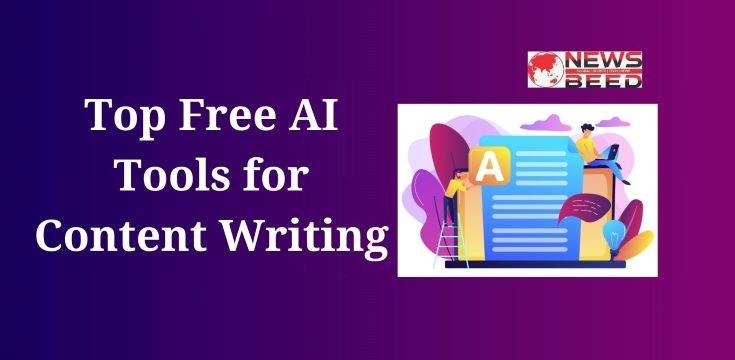Top Free AI Tools: Artificial intelligence has revolutionized the way we create content. AI-powered content writing tools use machine learning algorithms to assist writers, marketers, and content creators in generating high-quality text quickly and efficiently. These tools can help with tasks like generating blog posts, product descriptions, social media content, and more.
Here are some of the top free AI tools for content writing:
- OpenAI’s GPT-3: OpenAI’s GPT-3 (Generative Pre-trained Transformer 3) is a state-of-the-art language model. Although access to GPT-3 was initially limited, many applications and platforms have integrated it, allowing users to harness its powerful content generation capabilities. GPT-3 can assist with writing in various styles and formats.
- Copy.ai: Copy.ai is a user-friendly AI writing tool that offers a range of content generation features. It can help you create blog post ideas, product descriptions, social media posts, and more. Users can input prompts, and Copy.ai generates content based on those prompts.
- ShortlyAI: ShortlyAI is a versatile AI writing assistant that can assist you in drafting content, brainstorming ideas, and generating creative text. It’s known for its ability to produce content that sounds natural and engaging.
- Writesonic: Writesonic is an AI content generator that offers various content creation templates. Users can input a brief, and Writesonic generates content in the form of blog posts, emails, social media posts, and more. It also provides a plagiarism checker.
Also, Read This: What is Digital Marketing in Hindi
- Surfer SEO: Surfer SEO is primarily an SEO tool, but it includes an AI-powered content editor. This feature helps you optimize your content for search engines by analyzing top-ranking pages and suggesting improvements to your content.
- Wordtune: Wordtune is an AI-powered writing tool that assists you in improving the clarity and style of your writing. It provides suggestions for rephrasing sentences and making them more concise and engaging.
- Content Bot: Content Bot is a content generation tool that specializes in e-commerce and product descriptions. It can help you create product listings and descriptions that are both informative and persuasive.
- Kafkai: Kafkai is another AI content generator that focuses on creating articles and blog posts. It allows users to input a topic and generate high-quality, well-structured content.
- Jarvis (formerly Conversion.ai): Jarvis is a popular AI copywriting tool that assists with various writing tasks. It can help you create website content, ad copy, blog posts, and more. Users can provide prompts, and Jarvis generates content based on those prompts.
- SEO Content Machine: SEO Content Machine is an AI content generator designed for SEO professionals and content marketers. It can help you create content for your website while ensuring it’s optimized for search engines.
How These AI Tools Work
AI-powered content writing tools rely on advanced natural language processing (NLP) algorithms and large datasets to generate text. Here’s a general overview of how they work:
- Data Training: These tools are trained on vast amounts of text data from the internet. During this training process, the AI models learn the patterns, language structures, and context of various types of content.
- Input and Prompt: Users provide input in the form of prompts, briefs, or specific instructions. This input guides the AI in understanding the context and purpose of the content to be generated.
- Content Generation: The AI model then generates content based on the input and the patterns it has learned during training. The output can be in the form of paragraphs, blog posts, product descriptions, social media content, and more.
- Content Review and Editing: After the AI generates the content, users can review and edit it to ensure it meets their specific requirements and style preferences. Editing is often necessary to fine-tune the output.
- Iterative Process: Content creation with AI tools is often an iterative process. Users may need to refine their prompts or make multiple attempts to get the desired output.
Advantages of Using AI-Powered Content Writing Tools
Using AI-powered content writing tools offers several advantages:
- Time Efficiency: AI tools can generate content quickly, saving writers a significant amount of time.
- Consistency: AI tools can maintain a consistent writing style and tone throughout a piece of content.
- Idea Generation: These tools can help writers brainstorm ideas and overcome writer’s block.
- Language Assistance: AI tools can assist non-native English speakers in improving their writing.
- SEO Optimization: Some tools offer SEO suggestions to improve content visibility.
- Content Variety: AI can create content for different purposes, from blog posts to social media updates.
- Productivity: Content creators can produce more content in less time with AI assistance.
Limitations and Considerations
While AI-powered content writing tools offer numerous benefits, there are also limitations and considerations to keep in mind:
- Quality Variability: The quality of AI-generated content can vary, and it may not always meet your specific requirements without editing.
- Plagiarism Concerns: It’s essential to review AI-generated content for potential plagiarism, as the AI may inadvertently generate text similar to existing sources.
- Lack of Creativity: AI lacks true creativity and may struggle with highly creative or artistic content.
- Context Understanding: AI may not always fully grasp the context or nuances of certain topics, leading to inaccuracies.
- Overreliance: Relying solely on AI-generated content can result in a loss of authenticity and human touch in your writing.
- Privacy: Some AI tools may store user data, so it’s crucial to review their privacy policies.
- Subscription Costs: While many AI tools offer free plans, advanced features often require paid subscriptions.
Best Practices for Using Free AI Tools for Writing
To get the most out of AI-powered content writing tools, consider the following best practices:
- Edit and Review: Always review and edit the content generated by AI to ensure it aligns with your brand’s voice and message.
- Use as a Tool, Not a Replacement: Think of AI as a writing assistant rather than a replacement for human creativity and expertise.
- Avoid Plagiarism: Use plagiarism-checking tools to ensure the content is unique and doesn’t inadvertently copy from other sources.
- Understand the Audience: Tailor the content to your target audience’s preferences and needs.
- Experiment and Iterate: Experiment with different prompts and approaches to fine-tune the AI’s output.
- Combine with Human Input: Consider using AI in conjunction with human writers to maximize both efficiency and quality.
Also, Read This: What is SEO? Type and Key Factors of SEO
Conclusion
AI-powered content writing tools have become invaluable resources for content creators, marketers, and businesses looking to streamline their content production processes. While they offer many benefits, it’s crucial to use them wisely, review their output, and maintain the authenticity and quality of your content.




